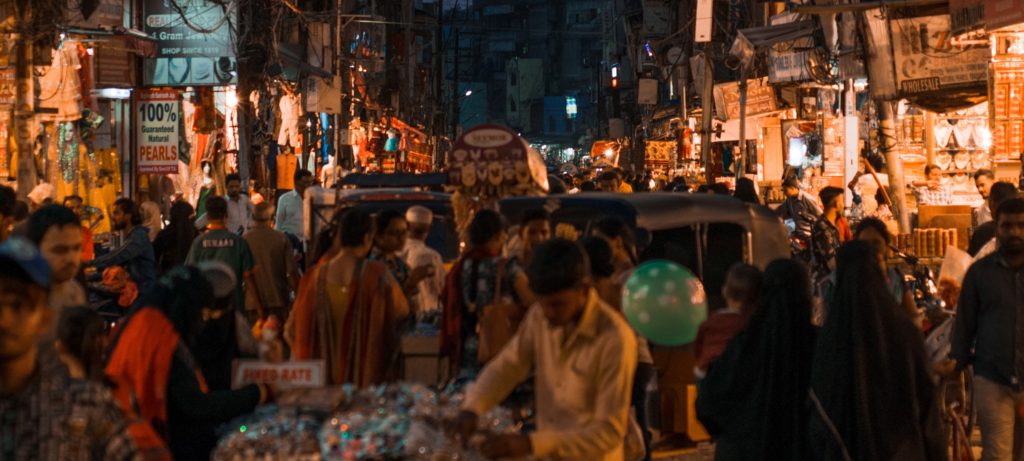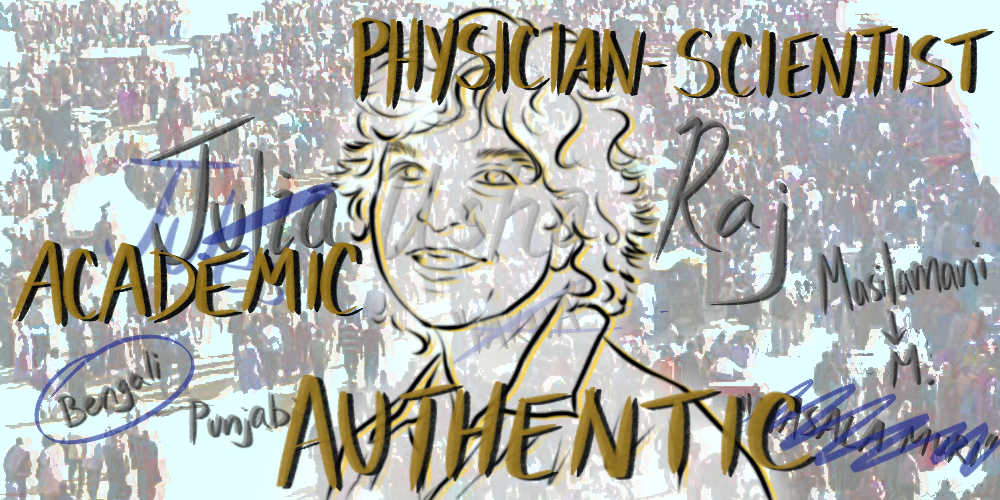One evening when I was seven, my mother showed me and my brothers a large neon sign on the side of a high-rise in the heart of the bustling city of Calcutta. Against the dark outline of the building, a huge ceiling fan whirred, its blades outlined in neon. As I watched, the projection faded, replaced by the outline of a table-top sewing machine with the wheel on one end turning around as the needle bobbed up and down at the other end. And as we watched, spellbound standing by the side of the road, the sewing machine faded away and the letters U S H A in bold neon capitals showed up.
What! Named after a fan! A sewing machine! “Amma, you told me I was named for a goddess!” I screeched. My mother explained that when she had arrived in the big city of Calcutta from a small town in south India, she had been thrilled to see this amazing neon sign with its unusual name, so she named me Usha. “And Usha is also the name of the goddess of dawn,” she consoled me. But my brothers could not miss this chance to tease me and immediately took to calling me “pakha,” the Bengali word for fan.
Then there was the complication of my last name. In India, people like to pigeonhole everyone by race, caste, religion, and social status. Often the last name can give up all this information. As early as in third grade, a classmate piped up, “You are not Bengali, are you? Your last name Raj sounds Punjabi but you don’t look Punjabi! You are so dark!”
“My parents are from South India, not Punjab,” I said.
“But you don’t have a South Indian name,” she exclaimed.
People in South India use a naming system in which everyone has a given name and an initial in front of it. The first name is often from the Vedas, the Hindu scriptures, as the vast majority of Indians are Hindus. And the initial stands for the name of the village the family comes from. My father’s Hindu ancestors had converted to Christianity, so my father’s given name was Samuel, but like all South Indians, he grew up as M. Samuel, M. standing for Masilamani, the village where his ancestors came from. But people from North India had a first and last name, the last name being the family name, like most people in the world. So when my father went away to a large college in a very cosmopolitan city, he wanted to be like most of the others so he converted his “pet-name” Raji, a name his mother called him, to Raj and used it as his last name. In Sanskrit Raj means rule, and Raj also signifies royalty, which was appropriate as his ancestors had been kings of small kingdoms in the South.
To appease my classmate I made the mistake of telling her that I too had an initial, M. like a true South Indian, M. for Masilamani. Now, most North Indians find South Indian names to be “tongue-twisters” and would often mispronounce the names deliberately and make fun of them. Not surprisingly she changed Masilamani to “Masala Muri,” which means spiced puffed rice, a very popular snack eaten by Bengalis and sold by street vendors. So I often heard the chant “Masala Muri! Masala Muri!” across the schoolyard when I walked by.
When I was 11, I got a chance to change my name. My Christian parents had never baptized me, so prior to my confirmation, they decided to do it. By this point, I spoke Bengali fluently without an accent and could even recite poems of Ravindranath Tagore, the Nobel laureate from Bengal, at our neighborhood get-togethers with the right intonations, a necessary talent for every Bengali. So if I was to be baptized, I wanted a Bengali name and to rid of ‘Usha” altogether so I could fit right in. But my mother was having none of that. “Just a Christian name from the Bible to add to your Indian name,” she said. I picked Jules from Jules and Jim, a movie that had just come out. I had no idea what it was about, but I liked the name Jules.
However that option was thrown out by my mother because it was not a name from the Bible, so I settled for Julia from Romans, which was the closest I could get to Jules. And the next year, when we moved to a new city, Bombay, I ventured forth with a new name, Julia Raj, to my new school, Bombay Scottish High School. I thought that this name would be easier to carry around — but it was not that simple.
In Bombay, all my classmates were either Parsis (Zoroastrians who had escaped from Persia) or Hindus from the Western Indian states. “Julia, that’s an Anglo name, does that mean you are an Anglo?” I was asked. Another category that I did not want to belong to: the mixed-race people left over from when the British were in India. “Anglos” in India had the problem of wanting to be British and having a superior attitude towards Indians but not being British enough to be looked up to by Indians. “No, I’m a South Indian Christian, not an Anglo!” So, less than a year after I acquired Julia, I suppressed it to an initial and became J. Usha Raj.
•
Belonging. There is such a strong desire within us to belong. Looking back, all my efforts at finding the right name were because I wanted to belong to one group, a group that I could identify with fully. My mother was from Andhra Pradesh where they spoke Telugu — I could understand it well but was not fluent in it — and my father was from Tamil Nadu where they spoke Tamil — and I did not understand nor speak it. I spent my childhood in Bengal and now I lived in Bombay where they spoke Marathi mainly, but also Gujarati, Sindhi, and Hindi, most of which I did not speak, except Hindi, the national language which I spoke very imperfectly. So there was not a group that I could quite fit in.

In India, one’s name is also linked to one’s race. The concept of two distinct races in India, the Aryans and Dravidians, is thought to be the product of an unscientific, culturally biased form of thinking that saw race in terms of color. This was emphasized by the British so they could place a wedge between North and South India, and they attributed a “higher” Aryan race to the north as they were lighter skinned, and a “lower” Dravidian race to the South.
Historically, there is some evidence to suggest that the Aryans (a sub-division of the Caucasian race) arrived in North India from Iran and Southern Russia around 1500 BC, and beat back indigent Dravidians to the south. But there is controversy as to which race Dravidians belong to, as some anthropologists categorize them as a sub-group of Caucasians, just much darker and shorter as they lived close to the equator. The North Indian Aryans are generally more confident, dominant both in business and social situations, and tall, light-skinned, and “good-looking” according to Caucasian norms. South Indians are mainly Dravidians and are shorter, darker skinned and while considered more intelligent, were often less confident in society.
After India’s independence from the British, the national Census of independent India officially stopped recognizing any racial group in India. And in support of this stance, Prof. Lalji Singh, a molecular biologist in India, debunked the Aryan-Dravidian controversy, and along with his team of scientists, wrote, “We have conclusively proven that there never existed any Aryans or Dravidians in the Indian sub-continent. No foreign genes or DNA has entered the Indian mainstream in the last 60,000 years.”
But little attention is paid to scientific data, even now in modern-day India. Great import is still granted to which race, religion, and caste one belongs to, and as I said, this is evident from one’s name. It is believed that the Aryan invaders created the caste system and put themselves in the highest caste, Brahmins or the priests, which is followed by the Kshatriyas (the warrior class), the Vaisyas (the trading class), and the Sudras (the servants). And then there are the Dalits, the untouchables, who do not have a caste. These divisions continue to have a far-reaching and long-lasting negative effect on society in India, especially among the poor and in villages where large numbers are uneducated. Last year, India chose an “untouchable” Dalit, Ram Nath Kovind as its president. This was seen as a clever move by Prime Minister Modi as by nominating him president, he could secure all the Dalit votes he needed in the general election. But little has changed for the majority of Dalits in India. Recently in Una, a small town in Gujarat, the State that Prime Minister Modi is from, a mob of cow vigilantes brutally beat four young men for skinning dead cows, a task that was part of their job as saddle makers. These young men were from the “untouchable” caste. Last year, while visiting India, I heard about the tragic suicide of Rohith Vemula, a Ph.D. student at Hyderabad Central University. An untouchable, he had been shunned by his professors and some of the students. His assigned mentor, a high-caste professor, had refused to assign him his Ph.D. thesis topic. In his final note, the young man called his birth a “fatal accident.”
All Indians, whether Christian, Muslim, Buddhist, Jain, or Hindu, carry some vestiges of the caste system within them. Some Christians in India say that they are “Brahmin Christians,” thus claiming a higher status. My maternal grandmother came from a high-caste Aryan Brahmin family and my father was from the Nadar “Caste”, a sub-group of Dravidians who had risen to great prominence in the South. So I am an Aryan Brahmin, a Nadar Dravidian, an Andhra, a Tamilian, and a Methodist Christian. So what name should I choose?
But does one’s name have to reflect one’s genetic makeup, ethnic background, and one’s country and region of origin? As I grew older I did not want my name or my appearance to exclude me from groups of people that I wished to interact with, nor did I want it to define who I was. When I arrived in the U.S. as a young woman at the University of California San Francisco to start my career as a physician-scientist, I was very relieved to find a vast assortment of names and races among my colleagues. No one seemed to care much about what one’s name was or where we came from, rather people were more interested in the scientific discoveries we made. So finally, in my new home in the U.S., I felt comfortable with my name and could belong to a group, a group that I call “the Academics.”•




